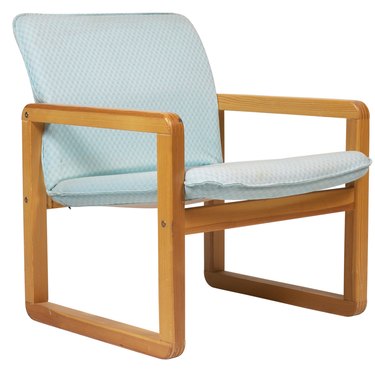 Teak was widely used in "Danish modern" furniture.
Teak was widely used in "Danish modern" furniture.
Woodworking is among the most complex of hobbies; it require a true lifetime of study and never allows its practitioners to become complacent. There is great satisfaction to be had in carefully crafting a piece of furniture that is capable of lasting for centuries as a family heirloom. The selection of woods is a fundamental aspect of woodworking, and two of the finest hardwoods are teak and walnut.
Video of the Day
Teak
Teak grows in tropical regions of Asia and Central America, where it is an important export. It is moderately hard, usually regarded as a "three" on a scale of one to five. The grain is straight and slightly coarse. It is a heavy, very durable wood, notorious among woodworkers for being very hard on tools. Those who work with teak sharpen and replace their tools regularly. Finished teak has a very warm appearance, with colors ranging from a pale yellow-gold to a deep brown-gold, but usually with a distinctive red tinge. Teak is very resistant to moisture.
Walnut
Walnut is a an excellent hardwood for furniture and cabinetmaking, with a fine and straight grain. It ranges in color from a very light tan to dark brown, almost black, in color. It has been widely used in American furniture at all periods, and its durability makes it an excellent choice for heirloom-quality work. Although strong and hard, walnut is easy to work with and is lighter than teak. It also takes finishes well.
Uses
Walnut is a premium domestic hardwood and has been used in quality furniture and cabinetry since the colonial period. It is also used in other "prestige" applications, such as architectural trims and moldings and the stocks of high-quality rifles and shotguns. Teak's durability and warm color have also made it popular for furniture, most notably the Danish Modern style popular in the mid-20th century. Teak's high resistance to water and moisture make it an excellent choice for outdoor furniture and yachts.
Sustainability
There are two main sources of walnut lumber. In America, walnut lumber is domestically produced and can be considered a sustainable option. In Europe, walnut is often imported from Africa, where sustainable harvesting is little practiced and the proceeds from the lumber often prop up unsavory regimes. This is also true of teak, most of which comes from Mayanmar, or Burma, where it provides the rulers with much-needed foreign currency. Many companies are now cultivating teak for market, but the buyer should be proactive in learning where the lumber originates.


